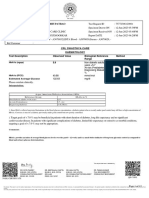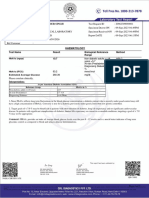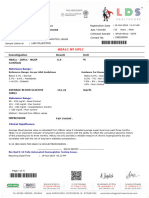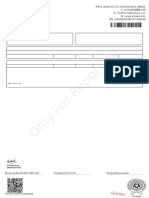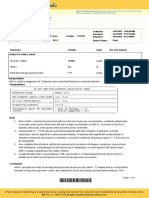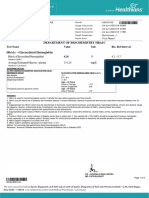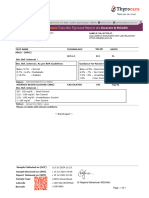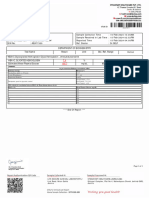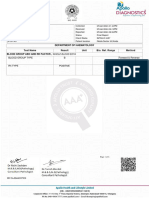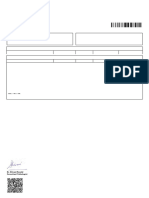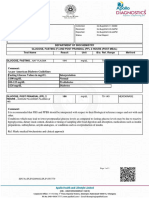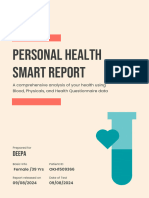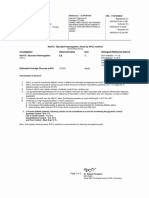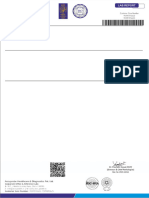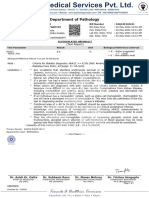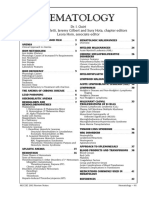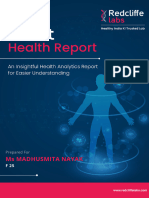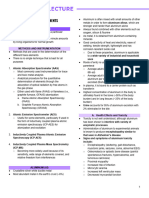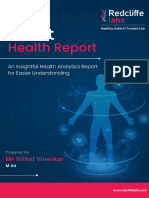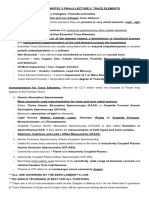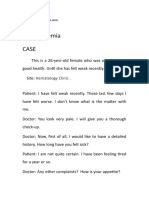Raj Rani
Raj Rani
Uploaded by
Manpreet SinghCopyright:
Available Formats
Raj Rani
Raj Rani
Uploaded by
Manpreet SinghOriginal Title
Copyright
Available Formats
Share this document
Did you find this document useful?
Is this content inappropriate?
Copyright:
Available Formats
Raj Rani
Raj Rani
Uploaded by
Manpreet SinghCopyright:
Available Formats
APTA11420
Patient NAME : Mrs.RAJ RANI Sample Collection Time : 24/Oct/2024 04:59PM
Age/Gender : 75 Y 0 M 0 D /F Sample Received in Lab Time : 24/Oct/2024 05:43PM
UAID/Oth.Lab Ref. : APTA.0000011200/ Reported Time : 24/Oct/2024 06:24PM
SIN No. : AFM12360 Ref. Doctor : Dr.SELF
DEPARTMENT OF BIOCHEMISTRY
MY HEALTHPACKAGE - 4
Test Name Result Unit Bio. Ref. Range Method
Calcium Serum , SERUM
CALCIUM 9.7 mg/dl 8.7 - 10.4 Arsenazo III
Comment:
Common causes of decreased value of calcium (hypocalcemia) are chronic renal failure, hypomagnesmia and hypoalbuminemia. Hypercalcemia (increased value of
calcium) can be caused by increased intestinal absorbtion (vitamin d intoxication ), increased skeletal reasorption (immobilization),or a combination of mechanisms
(primary hyperparathyroidism). Primary hyperparathyroidism and malignancy accounts for 90-95 % of all cases of hypercalcemia. Values of total calcium is affected by
serum proteins, particularly albumin thus, latter's value should be taken into account when interpreting serum calcium levels important source of preanalytical error in
the measurement of calcium is prolonged torniquet application during sampling. Thus, this along with fist clenching should be avoided before phlebotomy.
Critical value of Calcium established as per laboratory policy:
Adult : < 6.0 or > 13.0
Such critical value if obtained needs urgent medical attention.
Page 1 of 12
PATIALA COLLECTION CENTRE,PATIALA ATULAYA HEALTHCARE (MAIN REFERENCE LAB)
Opp Kansal Hospital,Preet Nagar Tripari Plot No 6,Sector 82 JLPL
Patiala SAS Nagar
APTA11420
Patient NAME : Mrs.RAJ RANI Sample Collection Time : 24/Oct/2024 04:59PM
Age/Gender : 75 Y 0 M 0 D /F Sample Received in Lab Time : 24/Oct/2024 05:42PM
UAID/Oth.Lab Ref. : APTA.0000011200/ Reported Time : 24/Oct/2024 07:06PM
SIN No. : AFM12361 Ref. Doctor : Dr.SELF
DEPARTMENT OF BIOCHEMISTRY
MY HEALTHPACKAGE - 4
Test Name Result Unit Bio. Ref. Range Method
HBA1C Glycosylated Hemoglobin Glyco Hemoglobin , WHOLE BLOOD EDTA
HBA1C, GLYCATED HEMOGLOBIN 5.2 % HPLC
Estimated Mean Plasma Glucose 102.5 mg/dL 65 - 136 Calculated
Comment:
As per American Diabetes Association (ADA)
Reference Group HbA1c in %
Non diabetic adults >= 18 years < 5.7
At risk (Prediabetes) 5.7 - 6.4
Diagnosing Diabetes >=6.5z
Good Control : <7.0
Therapeutic goals for glycemic control Fair Control : 7.0 - 8.0
Poor Control : >8.0
ADA criteria for correlation between HbA1c & Mean plasma glucose levels
HbA1c (%) Mean Plasma Glucose (mg/dL)
6 126
7 154
8 183
9 212
10 240
11 269
12 298
Page 2 of 12
PATIALA COLLECTION CENTRE,PATIALA ATULAYA HEALTHCARE (MAIN REFERENCE LAB)
Opp Kansal Hospital,Preet Nagar Tripari Plot No 6,Sector 82 JLPL
Patiala SAS Nagar
APTA11420
Patient NAME : Mrs.RAJ RANI Sample Collection Time : 24/Oct/2024 04:59PM
Age/Gender : 75 Y 0 M 0 D /F Sample Received in Lab Time : 24/Oct/2024 05:43PM
UAID/Oth.Lab Ref. : APTA.0000011200/ Reported Time : 24/Oct/2024 06:24PM
SIN No. : AFM12360 Ref. Doctor : Dr.SELF
DEPARTMENT OF BIOCHEMISTRY
MY HEALTHPACKAGE - 4
Test Name Result Unit Bio. Ref. Range Method
Electrolytes Serum , SERUM
SODIUM 140 mEq/L 132 - 146 Indirect Potentiometric
POTASSIUM 5.5 mEq/L 3.5 - 5.5 Indirect Potentiometric
CHLORIDE 101 mEq/L 99 - 109 Indirect Potentiometric
Comment:
Sodium levels are increased in dehydration, cushing's syndrome, aldosteronism & decreased in Addison's disease, hypopituitarism, liver disease. Hypokalemia (low K) is
common in vomiting, diarrhea, alcoholism, folic acid deficiency and primary aldosteronism. Hyperkalemia may be seen in end-stage renal failure, hemolysis, trauma,
Addison's disease, metabolic acidosis, acute starvation, dehydration, and with rapid K infusion. Chloride is increased in dehydration, renal tubular acidosis (hyperchloremia
metabolic acidosis), acute renal failure, metabolic acidosis associated with prolonged diarrhea and loss of sodium bicarbonate, diabetes insipidus, adrenocortical
hyperfuction, salicylate intoxication and with excessive infusion of isotonic saline or extremely high dietary intake of salt. Chloride is decreased in overhydration,
chronic respiratory acidosis, salt-losing nephritis, metabolic alkalosis, congestive heart failure, Addisonian crisis, certain types of metabolic acidosis, persistent gastric
secretion and prolonged vomiting.
Critical value of Sodium established as per laboratory policy:
Adult : < 120 or > 160
Critical value of Potassium established as per laboratory policy:
Adult : < 2.7 or > 6.0
Such critical value if obtained needs urgent medical attention.
Page 3 of 12
PATIALA COLLECTION CENTRE,PATIALA ATULAYA HEALTHCARE (MAIN REFERENCE LAB)
Opp Kansal Hospital,Preet Nagar Tripari Plot No 6,Sector 82 JLPL
Patiala SAS Nagar
APTA11420
Patient NAME : Mrs.RAJ RANI Sample Collection Time : 24/Oct/2024 04:59PM
Age/Gender : 75 Y 0 M 0 D /F Sample Received in Lab Time : 24/Oct/2024 05:43PM
UAID/Oth.Lab Ref. : APTA.0000011200/ Reported Time : 24/Oct/2024 06:24PM
SIN No. : AFM12360 Ref. Doctor : Dr.SELF
DEPARTMENT OF BIOCHEMISTRY
MY HEALTHPACKAGE - 4
Test Name Result Unit Bio. Ref. Range Method
Iron Studies (Iron & TIBC) , Serum
IRON 28.0 µg/dL 50 - 170 Ferrozine
UNSATURATED IRON BINDING CAPACITY 340.00 µg/dl 120 - 470 Calculated
TOTAL IRON BINDING CAPACITY ( TIBC) 368.0 µg/dL 250 - 450 Spectrophotometrically
% OF SATURATION 7.6 % 13 - 45 Calculated
Comment:
Transferrin is the primary plasma iron transport protein, which binds iron strongly at physiological pH. Transferrin is generally only 25% to 30% saturated with iron.
The additional amount of iron that can be bound is the unsaturated iron-binding capacity (UIBC). Diurnal variation is seen in serum iron levels—normal values in
midmorning, low values in midafternoon, very low values (approximately 10 μg/dL) near midnight.
TIBC measures the blood’s capacity to bind iron with transferrin (TRF). Estrogens and oral contraceptives increase TIBC levels. Asparaginase, chloramphenicol,
corticotropin, cortisone, and testosterone decrease the TIBC levels.
% saturation represents the amount of iron-binding sites that are occupied. Iron saturation is a better index of iron stores than serum iron alone. % saturation is decreased
in iron deficiency anemia (usually <10% in established deficiency).
Page 4 of 12
PATIALA COLLECTION CENTRE,PATIALA ATULAYA HEALTHCARE (MAIN REFERENCE LAB)
Opp Kansal Hospital,Preet Nagar Tripari Plot No 6,Sector 82 JLPL
Patiala SAS Nagar
APTA11420
Patient NAME : Mrs.RAJ RANI Sample Collection Time : 24/Oct/2024 04:59PM
Age/Gender : 75 Y 0 M 0 D /F Sample Received in Lab Time : 24/Oct/2024 05:43PM
UAID/Oth.Lab Ref. : APTA.0000011200/ Reported Time : 24/Oct/2024 06:24PM
SIN No. : AFM12360 Ref. Doctor : Dr.SELF
DEPARTMENT OF BIOCHEMISTRY
MY HEALTHPACKAGE - 4
Test Name Result Unit Bio. Ref. Range Method
Lipid Profile Screening , SERUM
TOTAL CHOLESTEROL 197.0 mg/dl 0.0 - 200 ChodPap
TRIGLYCERIDES 115.0 mg/dl 30 - 150 Enzymatic
HDL CHOLESTEROL 83.7 mg/dl 40 - 60 Direct
LDL CHOLESTEROL 90.3 mg/dl 0 - 100 Calculated
VLDL CHOLESTEROL 23.0 mg/dl 06 - 30 Calculated
CHOL / HDL RATIO 2.35 4-6 Calculated
LDL / HDL RATIO 1.08 0.5 - 3.0 Calculated
TRIGLYCERIDES/HDL RATIO 1.37 < 3.12 Calculated
NON-HDL CHOLESTEROL 113.3 mg/dl <130 Calculated
TOTAL LIPIDS 509.00 mg/dL 350 - 700 Calculated
Comment:
Triglycerides can show marked variation depending on previous day diet intake.
12 hrs fasting is mandatory before testing for lipid profile specially for triglyceride values.
In case, lipid profile is done in non-fasting state, then any abnormal value can come especially for triglycerides, LDL, VLDL
As per National Cholesterol Education Programme (NCEP) & guidelines
Total Cholestrol in mg/dl
<200 Desirable
200 - 239 Borderline
> or =240 High
LDL Cholestrol
< 100 Optimal
100 - 129 Near optimal
130 - 159 Borderline high
160 - 189 High
> or = 190 Very high
Triglycerides
< 150 Normal
150 to 199 Borderline high
200 to 499 High
> or = 500 Very high
Page 5 of 12
PATIALA COLLECTION CENTRE,PATIALA ATULAYA HEALTHCARE (MAIN REFERENCE LAB)
Opp Kansal Hospital,Preet Nagar Tripari Plot No 6,Sector 82 JLPL
Patiala SAS Nagar
APTA11420
Patient NAME : Mrs.RAJ RANI Sample Collection Time : 24/Oct/2024 04:59PM
Age/Gender : 75 Y 0 M 0 D /F Sample Received in Lab Time : 24/Oct/2024 05:43PM
UAID/Oth.Lab Ref. : APTA.0000011200/ Reported Time : 24/Oct/2024 06:24PM
SIN No. : AFM12360 Ref. Doctor : Dr.SELF
DEPARTMENT OF BIOCHEMISTRY
MY HEALTHPACKAGE - 4
Test Name Result Unit Bio. Ref. Range Method
Liver Function Screening , Serum
BILIRUBIN, TOTAL 0.60 mg/dL 0.3 - 1.10 Vanadate oxidation
BILIRUBIN CONJUGATED (DIRECT) 0.10 mg/dl < 0.3 Vanadate oxidation
BILIRUBIN (INDIRECT) 0.50 mg/dl 0.0 - 0.8 Calculated
ASPARTATE AMINOTRANSFERASE (AST/SGOT) 28.0 U/L < 34 UV without Pyrodoxal Po4
ALANINE AMINOTRANSFERASE (ALT/SGPT) 17.0 U/L 10 - 49 UV without Pyrodoxal Po4
ALKALINE PHOSPHATASE (ALP) 90.0 U/L 45 - 129 Modified IFCC
PROTEIN, TOTAL 7.53 g/dl 5.7 - 8.2 Biuret
ALBUMIN 4.39 g/dL 3.4 - 5.0 Spectrophotometry,BCP
GLOBULIN 3.14 gm/dl 3.0 - 4.0 Calculated
A/G RATIO 1.40 1.2 - 2.0 Calculated
Comment:
Bilirubin is a yellowish pigment found in bile and is a breakdown product of normal heme catabolism. Elevated levels results from increased bilirubin production (eg hemolysis and ineffective erythropoiesis); decreased bilirubin excretion
(eg; obstruction and hepatitis); and abnormal bilirubin metabolism (eg; hereditary and neonatal jaundice). Conjugated (direct) bilirubin is elevated more than unconjugated (indirect) bilirubin in viral hepatitis; drug reactions, alcoholic
liver disease conjugated (direct) bilirubin is also elevated more than unconjugated (indirect)bilirubin when there is some kind of blockage of the bile ducts like in Gallstones getting into the bile ducts tumors &Scarring of the bile ducts.
Increased unconjugated (indirect) bilirubin may be a result of hemolytic or pernicious anemia, transfusion reaction & a common metabolic condition termed Gilbert syndrome.
AST levels increase in viral hepatitis, blockage of the bile duct ,cirrhosis of the liver, liver cancer, kidney failure, hemolytic anemia, pancreatitis, hemochromatosis. Ast levels may also increase after a heart attck or strenuous activity.
ALT is commonly measured as a part of a diagnostic evaluation of hepatocellular injury, to determine liver health. Elevated ALP levels are seen in Biliary Obstruction, Osteoblastic Bone Tumors, Osteomalacia, Hepatitis,
Hyperparathyriodism, Leukemia, Lymphoma, paget`s disease, Rickets, Sarcoidosis etc.
Serum total protein, also known as total protein, is a biochemical test for measuring the total amount of protein in serum..Protein in the plasma is made up of albumin and globulin. Higher-than-normal levels may be due to: Chronic
inflammation or infection, including HIV and hepatitis B or C, Multiple myeloma,Waldenstrom's disease. Lower-than-normal levels may be due to: Agammaglobulinemia, Bleeding (hemorrhage), Burns, Glomerulonephritis, Liver
disease, Malabsorption, Malnutrition, Nephrotic - Human serum albumin is the most abundant protein in human blood plasma. It is produced in the liver.Albumin constitutes about half of the blood serum protein. Low blood albumin levels
(hypoalbuminemia) can be caused by: Liver disease like cirrhosis of the liver, nephrotic syndrome, protein-losing enteropathy, Burns, hemodilution, increased vascular permeability or decreased lymphatic clearance, malnutrition and
wasting etc.
Critical value of serum albumin established as per laboratory policy:
: < 1.5
Critical value of serum Bilirubin established as per laboratory policy:
0 - 3 months : >15
4 - 6 months: >20
Adult : > 15
Critical value of SGOT established as per laboratory policy:
: > 1000
Critical value of SGPT established as per laboratory policy:
: > 1000
Such critical value if obtained needs urgent medical attention.
Page 6 of 12
PATIALA COLLECTION CENTRE,PATIALA ATULAYA HEALTHCARE (MAIN REFERENCE LAB)
Opp Kansal Hospital,Preet Nagar Tripari Plot No 6,Sector 82 JLPL
Patiala SAS Nagar
APTA11420
Patient NAME : Mrs.RAJ RANI Sample Collection Time : 24/Oct/2024 04:59PM
Age/Gender : 75 Y 0 M 0 D /F Sample Received in Lab Time : 24/Oct/2024 05:43PM
UAID/Oth.Lab Ref. : APTA.0000011200/ Reported Time : 24/Oct/2024 06:24PM
SIN No. : AFM12360 Ref. Doctor : Dr.SELF
DEPARTMENT OF BIOCHEMISTRY
MY HEALTHPACKAGE - 4
Test Name Result Unit Bio. Ref. Range Method
Renal Function Screening , SERUM
UREA 25.68 mg/dL 10 - 50 Calculated
BLOOD UREA NITROGEN 12.0 mg/dl 5 - 23 Urease-GLDH
CREATININE 0.66 mg/dl 0.38 - 1.00 Jaffes, alkaline picrate
GFR, ESTIMATED 90.00 ml/min/1.73m2 Calculated
URIC ACID 4.00 mg/dl 3.1 - 7.8 Uricase/Peroxidase
BUN/CREATININE RATIO 18.18 10 - 25 Calculated
UREA/CREATININE RATIO 38.91 20 - 50 Calculated
Comment:
AGE IN YEARS GFR IN mL/min/1.73m2
20 - 29 116
30 - 39 107
40 - 49 99
50 - 59 93
60 - 69 85
>=70 75
Normal GFR >=90
Mild decrease in GFR 60 - 89
Moderate decrease in GFR 30 - 59
Sever decrease in GFR 15 - 29
Kidney Failure <15
Note
1. National Kidney Disease Education program recommends the use of MDRD equation to estimate or predict GFR in adults (>=20 years) with Chronic Kidney Disease
(CKD)
2. MDRD equation is most accurate for GFR <=60 mL/min/1.73m2
Critical value of BUN established as per laboratory policy:
Adult: > 60
Critical value of Creatinine established as per laboratory policy:
Adult : > 5.0
Such critical value if obtained needs urgent medical attention.
Page 7 of 12
PATIALA COLLECTION CENTRE,PATIALA ATULAYA HEALTHCARE (MAIN REFERENCE LAB)
Opp Kansal Hospital,Preet Nagar Tripari Plot No 6,Sector 82 JLPL
Patiala SAS Nagar
APTA11420
Patient NAME : Mrs.RAJ RANI Sample Collection Time : 24/Oct/2024 04:59PM
Age/Gender : 75 Y 0 M 0 D /F Sample Received in Lab Time : 24/Oct/2024 05:42PM
UAID/Oth.Lab Ref. : APTA.0000011200/ Reported Time : 24/Oct/2024 05:55PM
SIN No. : AFM12361 Ref. Doctor : Dr.SELF
DEPARTMENT OF HAEMATOLOGY
MY HEALTHPACKAGE - 4
Test Name Result Unit Bio. Ref. Range Method
Complete Blood Count (CBC) , WHOLE BLOOD EDTA
HAEMOGLOBIN 11.9 g/dl 12.0 - 15.0 Cyan-methemoglobin
RBC COUNT 3.90 million/µl 4.5 - 5.5 Optical(2-Dimensional technology)
PCV 38.8 % 36 - 46 Mathematical Calculation
MCV 99.5 fL 83 - 101 Measured, RBC Histogram
MCH 30.4 pg 27 - 32 Mathematical Calculation
MCHC 30.6 g/dl 31.0 - 34.5 Mathematical Calculation
R.D.W 16.1 % 11.5 - 14.5 Measured, RBC Histogram
TOTAL LEUCOCYTE COUNT 21000 cells/µL 4000 -10000 Peroxidase/Basophil/Lobularity
DIFFERENTIAL LEUCOCYTE COUNT (DLC)
NEUTROPHILS 86.1 % 40 -80 Peroxidase (Flowcytometry)
ABSOLUTE NEUTROPHIL COUNT 18,081 /µl 2000 - 7000 Peroxidase (Flowcytometry)
LYMPHOCYTES 8.8 % 20 - 45 Peroxidase (Flowcytometry)
ABSOLUTE LYMPHOCYTE COUNT 1,848 /µl 1000 - 3000 Peroxidase (Flowcytometry)
MONOCYTES 2.4 % 02 -10 Peroxidase (Flowcytometry)
ABSOLUTE MONOCYTE COUNT 504.0 /µl 200 - 1000 Peroxidase (Flowcytometry)
EOSINOPHILS 2.2 % 1-6 Peroxidase (Flowcytometry)
ABSOLUTE EOSINOPHIL COUNT 462.0 /µl 20-500 Peroxidase (Flowcytometry)
BASOPHILS 0.5 % 00 - 02 Basophil/Lobularity(Flowcytometry)
ABSOLUTE BASOPHIL COUNT 105.0 /µl 20 - 100 Basophil/Lobularity(Flowcytometry)
PLATELET COUNT 385000 cells/µl 150000 - 410000 Optical(2-Dimensional technology)
PCT 0.35 % 0.19 - 0.39 Mathematical calculation
MPV 9.0 fL 6.8 - 10.9 Measured Platelet Histogram
NUCLEATED RED BLOOD CELLS % 0.00 % <0.01 Peroxidase/Basophil/Lobularity
NUCLEATED RED BLOOD CELLS 0.0
Comment:
A complete blood count is a blood panel that gives information about the cells in a patient's blood, such as the cell count for each cell type. It is done on automated cell counter. The sample collected in EDTA is well preserved for 1 day.
After 24 – 48 hrs, RBC morphology show increased in MCV & HCT. All abnormal haemograms are reviewed and confirmed microscopically.
Critical value of Hemoglobin established as per laboratory policy: Adult : < 7.0 or > 20, NewBorn : < 10 or > 22, Critical value of TLC established as per laboratory policy: Adult : < 2000 or > 30000 NewBorn : < 2000 or > 43000,
Critical value of PCV established as per laboratory policy: Adult : < 20 or > 60 NewBorn : < 33 or > 71, Critical value of Platelets established as per laboratory policy: Adult : <40000 or > 1000000. Such critical value if obtained needs
urgent medical attention.
Page 8 of 12
PATIALA COLLECTION CENTRE,PATIALA ATULAYA HEALTHCARE (MAIN REFERENCE LAB)
Opp Kansal Hospital,Preet Nagar Tripari Plot No 6,Sector 82 JLPL
Patiala SAS Nagar
APTA11420
Patient NAME : Mrs.RAJ RANI Sample Collection Time : 24/Oct/2024 04:59PM
Age/Gender : 75 Y 0 M 0 D /F Sample Received in Lab Time : 24/Oct/2024 05:42PM
UAID/Oth.Lab Ref. : APTA.0000011200/ Reported Time : 24/Oct/2024 05:55PM
SIN No. : AFM12361 Ref. Doctor : Dr.SELF
DEPARTMENT OF HAEMATOLOGY
MY HEALTHPACKAGE - 4
Test Name Result Unit Bio. Ref. Range Method
Page 9 of 12
PATIALA COLLECTION CENTRE,PATIALA ATULAYA HEALTHCARE (MAIN REFERENCE LAB)
Opp Kansal Hospital,Preet Nagar Tripari Plot No 6,Sector 82 JLPL
Patiala SAS Nagar
APTA11420
Patient NAME : Mrs.RAJ RANI Sample Collection Time : 24/Oct/2024 04:59PM
Age/Gender : 75 Y 0 M 0 D /F Sample Received in Lab Time : 24/Oct/2024 05:43PM
UAID/Oth.Lab Ref. : APTA.0000011200/ Reported Time : 24/Oct/2024 06:45PM
SIN No. : AFM12360 Ref. Doctor : Dr.SELF
DEPARTMENT OF IMMUNOLOGY
MY HEALTHPACKAGE - 4
Test Name Result Unit Bio. Ref. Range Method
Vitamin B12 , Serum
VITAMIN B12 >2000 pg/mL 211 - 911 C.L.I.A
High levels of vitamin B12 may be seen in cirrhosis, hepatitis, kidney diseases, haemological malignancies(chronic
myeloid leukemia, polycythenia, patients on medication, myoproliferative syndrome, hypereoinophilic syndrome)
Comment:
Vitamin B12 deficiency frequently causes macrocytic anemia, glossitis, peripheral neuropathy, weakness, hyperreflexia, ataxia, loss of proprioception, poor coordination,
and affective behavioral changes. A significant increase in RBC MCV may be an important indicator of vitamin B12 deficiency.
Patients taking vitamin B12 supplementation may have misleading results. A normal serum concentration of B12 does not rule out tissue deficiency of vitamin B12 .
The most sensitive test for B12 deficiency at the cellular level is the assay for MMA. If clinical symptoms suggest deficiency, measurement of MMA and homocysteine
should be considered, even if serum B12 concentrations are normal.
Critical value of VIT B12 established as per laboratory policy:
Adult : > 2000
Such critical value if obtained needs urgent medical attention.
Vitamin D 25 Hydroxy (D3) , Serum
VITAMIN D (25 - OH VITAMIN D) 28.66 ng/mL CLIA
Comment:
BIOLOGICAL REFERENCE RANGES
VITAMIN D STATUS VITAMIN D 25 HYDROXY (ng/mL)
DEFICIENCY <20
INSUFFICIENCY 20 – <30
SUFFICIENCY 30 – 100
TOXICITY >100
The assay measures both D2 (Ergocalciferol) and D3 (Cholecalciferol) metabolites of vitamin D.Vitamin D status is best determined by measurement of 25 hydroxy
vitamin D, as it is the major circulating form and has longer half life ( 2-3 weeks) than 1,25 Dihydroxy vitamin D ( 5-8 hrs)
The reference ranges discussed in the preceding are related to total 25-OHD; as long as the combined total is 30 ng/mL or more, the patient has sufficient vitamin D.
Levels needed to prevent rickets and osteomalacia (15 ng/mL) are lower than those that dramatically suppress parathyroid hormone levels (20–30 ng/mL). In turn, those
levels are lower than levels needed to optimize intestinal calcium absorption (34 ng/mL). Neuromuscular peak performance is associated with levels approximately 38
ng/mL.
Critical value of VIT D established as per laboratory policy:
: > 100
Such critical value if obtained needs urgent medical attention.
Page 10 of 12
PATIALA COLLECTION CENTRE,PATIALA ATULAYA HEALTHCARE (MAIN REFERENCE LAB)
Opp Kansal Hospital,Preet Nagar Tripari Plot No 6,Sector 82 JLPL
Patiala SAS Nagar
APTA11420
Patient NAME : Mrs.RAJ RANI Sample Collection Time : 24/Oct/2024 04:59PM
Age/Gender : 75 Y 0 M 0 D /F Sample Received in Lab Time : 24/Oct/2024 05:43PM
UAID/Oth.Lab Ref. : APTA.0000011200/ Reported Time : 24/Oct/2024 06:45PM
SIN No. : AFM12360 Ref. Doctor : Dr.SELF
DEPARTMENT OF IMMUNOLOGY
MY HEALTHPACKAGE - 4
Test Name Result Unit Bio. Ref. Range Method
Thyroid Profile (Total T3, Total T4, Ultrasensitive TSH) , Serum
TRI-IODOTHYRONINE (T3, TOTAL) 0.84 ng/mL 0.60 - 1.81 C.L.I.A
THYROXINE (T4, TOTAL) 7.60 ug/dl 3.2 - 12.6 C.L.I.A
ULTRASENSITIVE TSH 7.100 µIU/ml 0.55 - 4.78 C.L.I.A
Comment:
Interpretations(s):
TSH stimulates the production and secretion of the metabolically active thyroid hormones, thyroxine (T4) and triiodothyronine (T3), by interacting with a specific receptor on the thyroid cell surface. The synthesis and secretion of TSH
is stimulated by Thyrotropin releasing hormone (TRH), in response to low levels of circulating thyroid d hormones. Elevated levels of T3 and T4 suppress the production of TSH via a classic negative feedback mechanism. Failure at
any level of regulation of the hypothalamic-pituitary-thyroid axis will result in either underproduction (hypothyroidism) or overproduction (hyperthyroidism) of T4 and/or T3.
Limitations:
T3 and T4 circulates in reversibly bound form with Thyroid binding globulins (TBG), and to a lesser extent albumin and Thyroid binding Pre-Albumin, so conditions in which TBG and protein levels alter such as pregnancy, excess
estrogens, androgens, steroids may falsely affect the T3 and T4 levels. Normal levels of T4 can also be seen in Hyperthyroid patients with: T3 Thyrotoxicosis, hypoproteinaemia or Ingestion of certain drugs. Serum T4 levels in neonates
and infants are higher than values in the normal adult, due to the increased concentration of TBG in neonate serum, TSH may be normal in central hypothyroidism, recent rapid correction of hyperthyroidism or hypothyroidism,
pregnancy, phenytoin therapy. Autoimmune disorders may produce spurious result. Various drugs can interfere with the test result. TSH has a diurnal rhythm so values may vary if sample collection is done at different times of the day.
Recommended test for T3 and T4 is unbound fraction or free levels as it is metabolically active.
Time of sampling or food intake alter TSH levels. Recommended sample for thyroid tests is morning fasting sample (Shriram Mahadevn et al)
Each individual circadian rhythm is different, so for serial readings, one should always give the sample at the exact same time of the day every time.
Reference Intervals:
Age T3 (ng/ml) T4 (µg/dL) TSH (µIU/mL)
Adults 0.60 – 1.81 3.20 – 12.6 0.55 – 4.78
For Pregnant females (As per American Thyroid Association)
First Trimester 0.10 – 2.50
Second Trimester 0.20 – 3.00
Third Trimester 0.30 – 3.00
CONDITIONS / PREREQUISITES OF REPORTING
1. Identity of patient is not verified. Test results released pertain to the specimen submitted.
2. All test results are dependent on the quality of the specimen received by the Laboratory.
3. Investigations are only a tool to facilitate in arriving at a diagnosis and should be clinically correlated by the Referring Physician.
4. Please note that results of the test(s) may vary from laboratory to laboratory depending on the technology and methodology used. Furthermore, some parameters may vary from time to time
even for the same patient. Test result may vary based on the time of collection, physiological condition, any medicine consumed, nutritional / diet change. Sometimes test(s) may have to be
repeated in the interest of quality assurance.
5. In certain instances, a second specimen may be required from the patient on account of an indeterminate result, or pre-analytical / analytical reason.
6. Some tests are referred to other laboratories to provide a wider test menu to the patient. In such cases, the test reports may get delayed and those tests are marked as #.
7. Delay in issuing test reports may occur due to unavoidable/unforeseen circumstances like shortage or non-availability of the test kits or instrument failure etc.
8. In the case of alarming and unexpected test results, you are advised to contact the laboratory immediately for further discussions and action. Laboratory results are meant to be correlated with
the patient's clinical history. In such circumstances please call at: 0172 455 8888 / 97795 99499
9. Reporting of tests will be as per the defined laboratory turnaround time (TAT) for each test. The same will be informed to the patient during registration and/or phlebotomy. Tests not under the
scope of NABL accreditation have been highlighted with an *.
10. Please note: Histopathology specimens are retained for 6 months only from the date of the sample collection and blocks & slides are retained for 10 years from the date of its reporting. A
minimum of 48 hours prior notice is required for the issuing of the slides and blocks.
11. Test results are not valid for Medico Legal purposes. Neither Atulaya Healthcare nor its directors/employees/representatives assume any liability or responsibility, for any loss or damage or
expenditure that may be incurred by any person, including the patient, as a result of assuming the meaning or contents of this report without further validation.
12. To maintain confidentiality, certain reports may not be mailed at the discretion of the management.
13. Subject to the jurisdiction of the Courts of Law in the Union Territory of Chandigarh.
14. This medical diagnostic report has been e-signed by Authorized Medical Practitioner/Doctor. The report does not need physical signature.
Page 11 of 12
PATIALA COLLECTION CENTRE,PATIALA ATULAYA HEALTHCARE (MAIN REFERENCE LAB)
Opp Kansal Hospital,Preet Nagar Tripari Plot No 6,Sector 82 JLPL
Patiala SAS Nagar
APTA11420
Patient NAME : Mrs.RAJ RANI Sample Collection Time : 24/Oct/2024 04:59PM
Age/Gender : 75 Y 0 M 0 D /F Sample Received in Lab Time : 24/Oct/2024 05:43PM
UAID/Oth.Lab Ref. : APTA.0000011200/ Reported Time : 24/Oct/2024 06:45PM
SIN No. : AFM12360 Ref. Doctor : Dr.SELF
DEPARTMENT OF IMMUNOLOGY
MY HEALTHPACKAGE - 4
Test Name Result Unit Bio. Ref. Range Method
*** End Of Report ***
Page 12 of 12
PATIALA COLLECTION CENTRE,PATIALA ATULAYA HEALTHCARE (MAIN REFERENCE LAB)
Opp Kansal Hospital,Preet Nagar Tripari Plot No 6,Sector 82 JLPL
Patiala SAS Nagar
You might also like
- Karamjit KaurDocument12 pagesKaramjit KaurManpreet SinghNo ratings yet
- Mrs - Lalita SharmaDocument8 pagesMrs - Lalita SharmaManju JaswalNo ratings yet
- Lab Report NewDocument12 pagesLab Report NewpropertyyaarNo ratings yet
- Mrs. Ganga Mallashette 19102024 053032 PMDocument10 pagesMrs. Ganga Mallashette 19102024 053032 PMjagdishapsingekarNo ratings yet
- Report GNDocument3 pagesReport GNPawan MadhesiyaNo ratings yet
- ReportDocument2 pagesReportranjithento27No ratings yet
- PDF TextDocument12 pagesPDF TextPratham BhopatraoNo ratings yet
- ReportDocument3 pagesReportPawan MadhesiyaNo ratings yet
- Screenshot 2023-12-09 at 5.41.51 PMDocument2 pagesScreenshot 2023-12-09 at 5.41.51 PManupkudubeyNo ratings yet
- LDSPLDocument3 pagesLDSPLpushamsharma52No ratings yet
- PDF TextDocument2 pagesPDF TextAmit PathakNo ratings yet
- PDF TextDocument13 pagesPDF Textshivamag3971740No ratings yet
- Mr. Sanjay Sakolkar 19102024 052724 PMDocument11 pagesMr. Sanjay Sakolkar 19102024 052724 PMjagdishapsingekarNo ratings yet
- ReportDocument1 pageReportsomesh dahujaNo ratings yet
- Sankar NarmadaDocument4 pagesSankar Narmadamajumdarranadip8No ratings yet
- Indu SharmaDocument16 pagesIndu SharmaManpreet SinghNo ratings yet
- SR9785497Document6 pagesSR9785497sg.digitalpoint93No ratings yet
- Bruwq11320m2bag5ae1yd2byDocument4 pagesBruwq11320m2bag5ae1yd2byHarsh Vardhan GoelNo ratings yet
- O P MalikDocument10 pagesO P MalikGarima MalikNo ratings yet
- Interpretation: S03 - FPSC DILSHAD COLONY (C004263143) J-50 Dilshad Colony, DelhiDocument6 pagesInterpretation: S03 - FPSC DILSHAD COLONY (C004263143) J-50 Dilshad Colony, DelhiAll VIDEOS TechNo ratings yet
- Mrs Sonali Upadhiya: Interpretation: Interpretation For Hba1C% As Per American Diabetes Association (Ada)Document3 pagesMrs Sonali Upadhiya: Interpretation: Interpretation For Hba1C% As Per American Diabetes Association (Ada)CHINMAY UPADHYAYA X-DNo ratings yet
- PdfText (1) - 8Document12 pagesPdfText (1) - 8Lavish MiddhaNo ratings yet
- LabReportNew - 2023-09-08T160827.328Document3 pagesLabReportNew - 2023-09-08T160827.328viraj kshirsagarNo ratings yet
- Shivam Path Kanti Devi (55Y/F) (2221365973), GURUKRIPA PATH LAB, TRILOCHAN UTTAR PARDESH, 222136Document1 pageShivam Path Kanti Devi (55Y/F) (2221365973), GURUKRIPA PATH LAB, TRILOCHAN UTTAR PARDESH, 222136surendarkumar3517No ratings yet
- Sathya VDocument2 pagesSathya VKrishna PrasathNo ratings yet
- Shahnwaz ShaikhDocument2 pagesShahnwaz ShaikhALINo ratings yet
- Department of Biochemistry Hba1C: Test Name Value Unit Bio. Ref IntervalDocument20 pagesDepartment of Biochemistry Hba1C: Test Name Value Unit Bio. Ref IntervalSheetal BHMCT21 107No ratings yet
- LabReportNew - 2024-02-19T163907.126Document1 pageLabReportNew - 2024-02-19T163907.126anil KumarNo ratings yet
- Department of Haematology: Test Name Result Unit Bio. Ref. Range MethodDocument6 pagesDepartment of Haematology: Test Name Result Unit Bio. Ref. Range MethodJaya LakshmiNo ratings yet
- Gobardhan Banik-65Document1 pageGobardhan Banik-65Sanjoy DasNo ratings yet
- Apollo247 250181882 LabreportDocument6 pagesApollo247 250181882 Labreportanshikha.mitNo ratings yet
- PdfText - 2023-10-16T101203.851Document12 pagesPdfText - 2023-10-16T101203.851Sanjana AntilNo ratings yet
- Af053c30317264547145 RLSDocument2 pagesAf053c30317264547145 RLSds1234049No ratings yet
- Mrs Neetu - ReportDocument14 pagesMrs Neetu - Reportyatan kapoorNo ratings yet
- Lab Report NewDocument14 pagesLab Report Newkaranjaat2024No ratings yet
- Fasting Blood GlucoseDocument7 pagesFasting Blood GlucosegoddeyNo ratings yet
- Report ViewerDocument1 pageReport ViewerMuhammad Mufakhar Jamil100% (1)
- CD080524127 Vimlesh 7bb8Document9 pagesCD080524127 Vimlesh 7bb8shuklanarender66No ratings yet
- Lab ReportDocument13 pagesLab ReportalvinakemNo ratings yet
- PHL B 559364636Document7 pagesPHL B 559364636Rishov DeyNo ratings yet
- CKABOPV148542Document3 pagesCKABOPV148542lavitasarma1185No ratings yet
- Personal Health Smart Report: DeepaDocument25 pagesPersonal Health Smart Report: Deepaamoghdrive3No ratings yet
- Hbaic NewDocument1 pageHbaic New09 Dnyaneshwar GutaleNo ratings yet
- Momat ShakirDocument2 pagesMomat ShakirALINo ratings yet
- Af053c30316704397700 RLSDocument2 pagesAf053c30316704397700 RLSds1234049No ratings yet
- Test PDFDocument2 pagesTest PDFAshutosh PandaNo ratings yet
- Mpix4185Document3 pagesMpix4185sairam4u99No ratings yet
- Mr. Sekar 1800032926 18025192:::::: Patient IDDocument1 pageMr. Sekar 1800032926 18025192:::::: Patient IDlakshmisekar umapathyNo ratings yet
- Lab Report NewDocument3 pagesLab Report Newmickyminie220695No ratings yet
- MR DharaminderDocument12 pagesMR DharaminderDeepak SinghNo ratings yet
- Report HYD89C76872810860226 2024 06 07 2Document4 pagesReport HYD89C76872810860226 2024 06 07 2SUNSHINE DIAGNOSTICSNo ratings yet
- Efbu2630Document4 pagesEfbu2630Aniruddh NagaNo ratings yet
- LabReportNew 13Document5 pagesLabReportNew 13komaljangra01111998No ratings yet
- BIOCHEMISTRYDocument1 pageBIOCHEMISTRYpritamchakzNo ratings yet
- Sattva Project 2 Project Analysis ReportDocument17 pagesSattva Project 2 Project Analysis ReportIt's your ChannelNo ratings yet
- Interpretation: A06 - Raj Hospital - Cash (Cghs - 20) Main Road Ranchi Jharkhand 834001Document4 pagesInterpretation: A06 - Raj Hospital - Cash (Cghs - 20) Main Road Ranchi Jharkhand 834001AlokNo ratings yet
- Department of Biochemistry Campaign Diabetic Check (With PP)Document2 pagesDepartment of Biochemistry Campaign Diabetic Check (With PP)gsm2008100% (1)
- Practical Transfusion Medicine for the Small Animal PractitionerFrom EverandPractical Transfusion Medicine for the Small Animal PractitionerNo ratings yet
- Understanding Laboratory Investigations: A Guide for Nurses, Midwives and Health ProfessionalsFrom EverandUnderstanding Laboratory Investigations: A Guide for Nurses, Midwives and Health ProfessionalsNo ratings yet
- 69th AACC Annual Scientific Meeting Abstract eBookFrom Everand69th AACC Annual Scientific Meeting Abstract eBookNo ratings yet
- Qdoc - Tips - 06 Clinical Pathology Mcqs With Answers 1Document29 pagesQdoc - Tips - 06 Clinical Pathology Mcqs With Answers 1Sandeep KumarNo ratings yet
- LPL - Lpl-Rohini (National Reference Lab) Sector - 18, Block - E Rohini DELHI 110085Document3 pagesLPL - Lpl-Rohini (National Reference Lab) Sector - 18, Block - E Rohini DELHI 110085Puneet jain.aca100% (1)
- AnemiaDocument20 pagesAnemiaبشير حيدرNo ratings yet
- Mrs. RIZWANADocument13 pagesMrs. RIZWANADRx Aazad SaifiNo ratings yet
- PdfText - 2023-06-01T222329.740Document8 pagesPdfText - 2023-06-01T222329.740Rahul NemadeNo ratings yet
- Hematology: Dr. I. Quirt Adriana Cipolletti, Jeremy Gilbert and Susy Hota, Chapter Editors Leora Horn, Associate EditorDocument42 pagesHematology: Dr. I. Quirt Adriana Cipolletti, Jeremy Gilbert and Susy Hota, Chapter Editors Leora Horn, Associate EditorRubyrose Tagum100% (1)
- LPLT12448 : LPL - Lpl-Rohini (National Reference Lab) Sector - 18, Block - E Rohini DELHI 110085Document6 pagesLPLT12448 : LPL - Lpl-Rohini (National Reference Lab) Sector - 18, Block - E Rohini DELHI 110085Kumar ManglamNo ratings yet
- Report 18 38Document22 pagesReport 18 38Abhisek PattnaikNo ratings yet
- Finals Cc2Document34 pagesFinals Cc2agdiazNo ratings yet
- Dr. Ritu Verma RNVV-1Document40 pagesDr. Ritu Verma RNVV-1drrituverma1No ratings yet
- Evaluation of The Ruminant Complete Blood Dell CountDocument26 pagesEvaluation of The Ruminant Complete Blood Dell CountDirección Científica Laboratorio VitalabNo ratings yet
- Report For ProjectDocument26 pagesReport For ProjectSwapnil ShirkeNo ratings yet
- Department of Hematology Comprehensive Full Body Checkup Test Name Result Unit Bio. Ref. IntervalDocument11 pagesDepartment of Hematology Comprehensive Full Body Checkup Test Name Result Unit Bio. Ref. IntervalshyamNo ratings yet
- Preparation of Iron-Enriched Baker's Yeast and Its Efficiency in Recovery of Rats From Dietary Iron DeficiencyDocument11 pagesPreparation of Iron-Enriched Baker's Yeast and Its Efficiency in Recovery of Rats From Dietary Iron DeficiencyAsdfNo ratings yet
- أمراض دم نظري-عملي3 مترجمةDocument11 pagesأمراض دم نظري-عملي3 مترجمةANGofran RaheemNo ratings yet
- ReportDocument24 pagesReportSugu GohainNo ratings yet
- Tam0121200074548917 RLSDocument10 pagesTam0121200074548917 RLSKichaaNo ratings yet
- GD Wellness Monsoon Camp: Complete Haemogram Test ErythrocytesDocument10 pagesGD Wellness Monsoon Camp: Complete Haemogram Test ErythrocytesLucky BoffinNo ratings yet
- Clin Chem Trace Elements SummarizedDocument8 pagesClin Chem Trace Elements SummarizedkitteushiromiyaNo ratings yet
- Traceability and Uncertainty of PreciNorm U Cobas - 10171743siDocument10 pagesTraceability and Uncertainty of PreciNorm U Cobas - 10171743siSylvain ContiéNo ratings yet
- ReportDocument16 pagesReportprachiNo ratings yet
- Medicine Triple ADocument186 pagesMedicine Triple AAnup Bhele100% (1)
- Liver Function Test: No. Investigation Observed Value Unit Biological Reference IntervalDocument10 pagesLiver Function Test: No. Investigation Observed Value Unit Biological Reference IntervalUNIQUE DIAGNOSTICNo ratings yet
- YGT22541Document13 pagesYGT22541Suraj SheikhNo ratings yet
- Normal ValuesDocument6 pagesNormal ValuesHazel CabreraNo ratings yet
- IDA HOMEWORK (2016510024-Putri Nurhisiyah Madya Jamil)Document9 pagesIDA HOMEWORK (2016510024-Putri Nurhisiyah Madya Jamil)Shanon LimNo ratings yet
- Clinical Chemistry 2 Lecture Notes in Trace ElementsDocument6 pagesClinical Chemistry 2 Lecture Notes in Trace ElementsMoira Pauline LibroraniaNo ratings yet
- Effect of Tea On Iron-AbsorptionDocument9 pagesEffect of Tea On Iron-AbsorptionVincentius JuanNo ratings yet
- NHLBI OSPEEC YourGuidetoAnemia Booklet RELEASE 508Document44 pagesNHLBI OSPEEC YourGuidetoAnemia Booklet RELEASE 508bnvjNo ratings yet
- Chapter 11 - Iron MetabolismDocument3 pagesChapter 11 - Iron MetabolismAira UsiNo ratings yet






